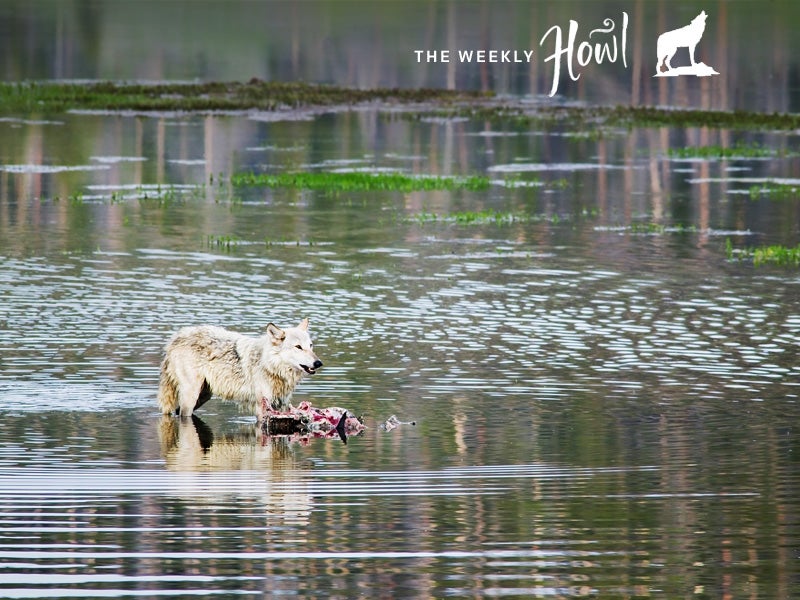How Wolves Saved the Foxes, Mice and Rivers of Yellowstone National Park
Yellowstone National Park was plagued by defoliation, erosion, and an unbalanced ecosystem, but everything changed when wolves were reintroduced to the park in 1995.

This page was published 9 years ago. Find the latest on Earthjustice’s work.
The land of Old Faithful wasn’t always so lush. Two decades ago, Yellowstone National Park was the victim of defoliation, erosion, and an unbalanced ecosystem. But in 1995, everything changed.
That was the year wolves were reintroduced to the park. Before then, government predator control programs had all but eliminated the gray wolf from America’s lower 48 states. Consequently, deer and elk populations increased substantially, resulting in overgrazing, particularly of willows and other vegetation important to soil and riverbank structure, leaving the landscape vulnerable to erosion. Without wolves, the entire ecosystem of the park suffered.
A short film, which has garnered more than 40 million views on YouTube, gives a captivating explanation for Yellowstone’s turnaround. British writer George Monbiot lends his voice to this documentary, and his zeal is infectious as he describes how wolves reinvigorated the park. “We all know that wolves kill many animals, but perhaps we’re slightly less aware that they give life to many others,” he says in the film. So much of our knowledge of these creatures focuses on their potential threat to humans, rather than their biological importance.
As a top predator, wolves are one of Yellowstone’s linchpins, holding together the delicate balance of predator and prey. Their removal in the early 20th century disrupted food webs and set off something called a “trophic cascade,” in which the wolves’ natural prey (in this case, elk) multiplied, all the while consuming increasing amounts of foliage. The phenomenon occurred again in reverse when the wolves were reintroduced and the natural balance was restored.
When wolves were brought back to the park, they not only killed elk, but also changed their prey’s behavior patterns. The herbivores started to avoid areas like valleys and gorges where they could be easily hunted by predators. As a result, those areas began to regenerate, and species such as birds, beavers, mice and bears returned. Plant life once again thrived along the riverbanks and erosion decreased significantly. The stabilization of the riverbanks actually made the rivers and streams change course. With the reintroduction of just a small population of wolves, the landscape of the whole park transformed.
Earthjustice has been fighting in the courts and on Capitol Hill for more than 20 years to protect wolves. In recent years, anti-wildlife politicians have attempted to undermine the Endangered Species Act by slipping contentious policy riders into must-pass spending bills in an attempt to strip wolves of federal protections.
In 2018, Congress added a record number of anti-wolf measures to House and Senate appropriations bills that fund the Department of the Interior, as well as to House defense authorization and energy bills. These measures would block Endangered Species Act protections for a variety of wolf populations, including:
- Mexican gray wolves, despite the fact that there are fewer than 100 of these imperiled animals left in the United States
- Gray wolves in Wyoming, Michigan, Minnesota, and Wisconsin, despite federal court decisions that found proposals to de-list these wolves illegal under the Endangered Species Act
- Gray wolves across the entire lower 48 states, despite the fact that wolves currently occupy just a small portion of their former range in the U.S.
If we don’t act now, wolves could again be subject to the same hostile extermination practices that pushed them to the brink of extinction. This video with George Monbiot demonstrates the importance of combating such legislation. Efforts to boost wild wolf populations are essential, not just for Canis lupus, but for the greater natural world.
The Weekly Howl: About this series
2015 marked the 20th anniversary of the reintroduction of gray wolves to the northern Rockies, and since that time wolves have been under nearly constant threat of losing their protections. This post is one in a series providing insights and education about the gray wolf and updates on the status of its protections while celebrating the iconic species as a vital part of a functioning, healthy ecosystem. Posts ran through the summer of 2015.